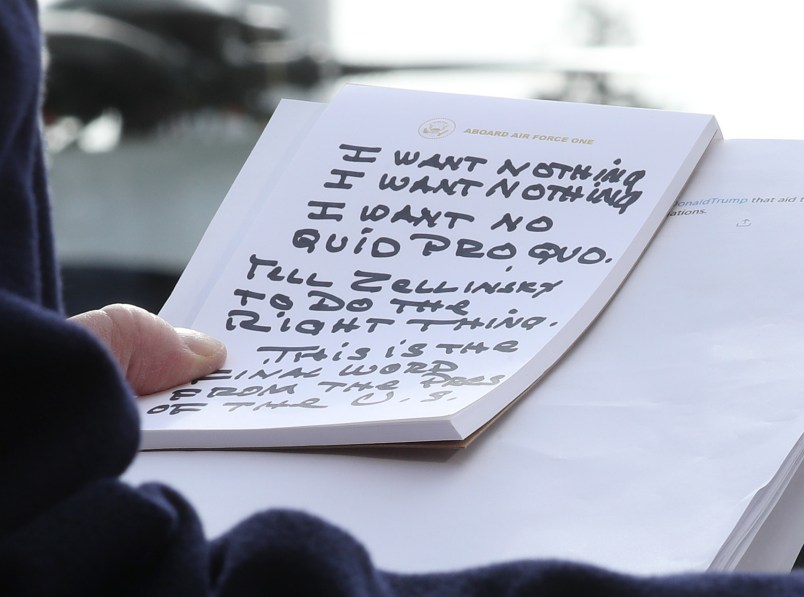Clarifying many points in the Ukraine scandal drama requires simply stating the obvious. And nowhere more so than in this now notorious Trump/Sondland phone call in which the President barked “no quid pro quo” to Sondland multiple times and said he wanted “nothing” from President Zelensky of Ukraine. The President and his supporters have rather implausibly put this forward as total exoneration. After all, in a private call, when asked what he wanted he said “no quid pro quo.”
But of course the timing and even the contextual logic is key.
The Trump/Sondland call was on September 9th. As we know, just two days later on September 11th the President did in fact release the aid because they’d been caught. The existence of the whistleblower report was going public. The jig was up.
More than a week earlier the acting Director of National Intelligence had gone to the White House Counsel’s office to get guidance on what to do with the whistleblower report on the President’s actions. This was after the White House Counsel’s office had learned that someone at the CIA had raised concerns. But at that point they knew definitively that there was a whistleblower report. The White House and the Justice Department went to great lengths to keep the report secret and avoid the statutory requirement to share it with the congressional intelligence committees. The DOJ’s Office of Legal Counsel issued a report on September 3rd that the report did not have to be shared with Congress.
It was on September 9th that Intelligence Community Inspector General Michael Atkinson forced the matter by notifying Chairmen Schiff and Burr of the existence of a whistleblower report without revealing its contents. There’s a bit of uncertainty – at least to me – about just when on the 9th the call took place and the letter arrived on the Hill. Atkinson sent the letter early morning on the 9th. The WhatsApp timestamps which place the timing of the Sondland/Trump call are ambiguous as to their timezone. Regardless it’s all but certain that the White House knew in advance about Atkinson’s letter.
When Sondland called Trump, Trump already knew there was a whistleblower report and he almost certainly knew that the effort to keep it from going to Chairman Schiff had failed. In other words, they were caught. It seems most probable that the White House and the President learned that the day before the call, though it’s possible they learned as late as that morning.
This is the backdrop to the call with Sondland. Presumably the President denied it because he knew he’d already gotten caught – something Sondland likely didn’t yet know.
There’s another clue to this. “Quid pro quo” is an investigative phrase. No one proposes a quid pro quo. It’s an investigative phrase about a corrupt bargain. Yet this is the phrase the President jumped to in response to what Sondland claims was an open-ended ask of ‘What do you want?’ This is another strong piece of circumstantial evidence that by the time Sondland called, Trump had already moved along from what he wanted to discussions with advisors and lawyers about his defense against the allegations made in the whistleblower report. If you think about it, the answer is simply absurd if the President isn’t already focused on his defense. “No quid pro quo!”
The fact the President was in a bellicose and grumpy mood probably points to his understandable unhappiness about getting caught. But that’s much less certain. He’d been grumpy in other exchanges too.
What’s quite clear though is that the President’s angry repeating of “no quid pro quo” wasn’t a statement about what he wanted. It was repeating a defense because, though Sondland didn’t know, the President knew the plot had been revealed. They were moving on from the plot to the cover up.






